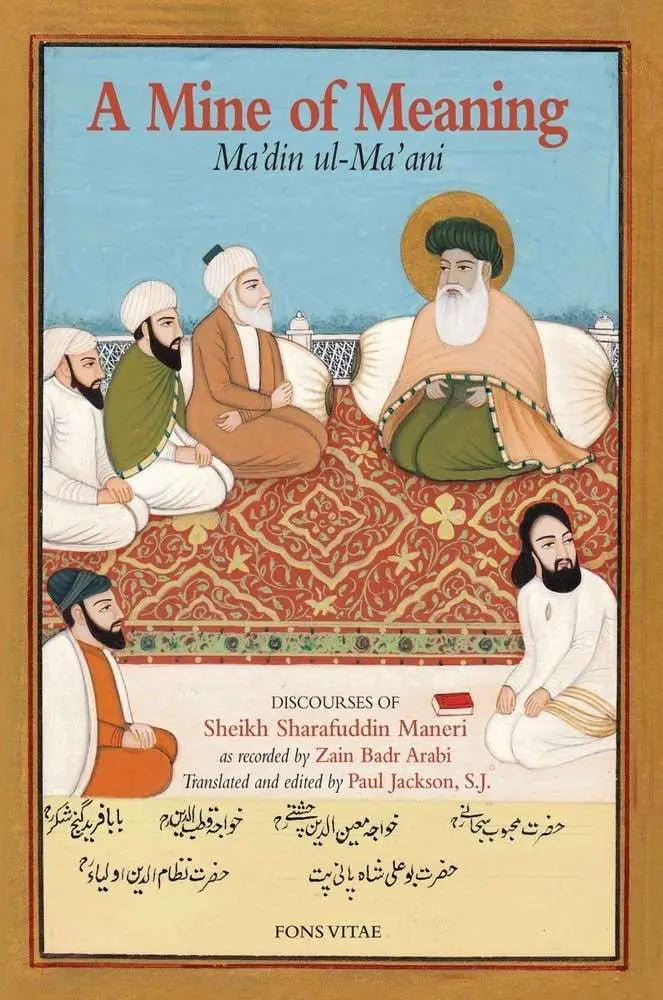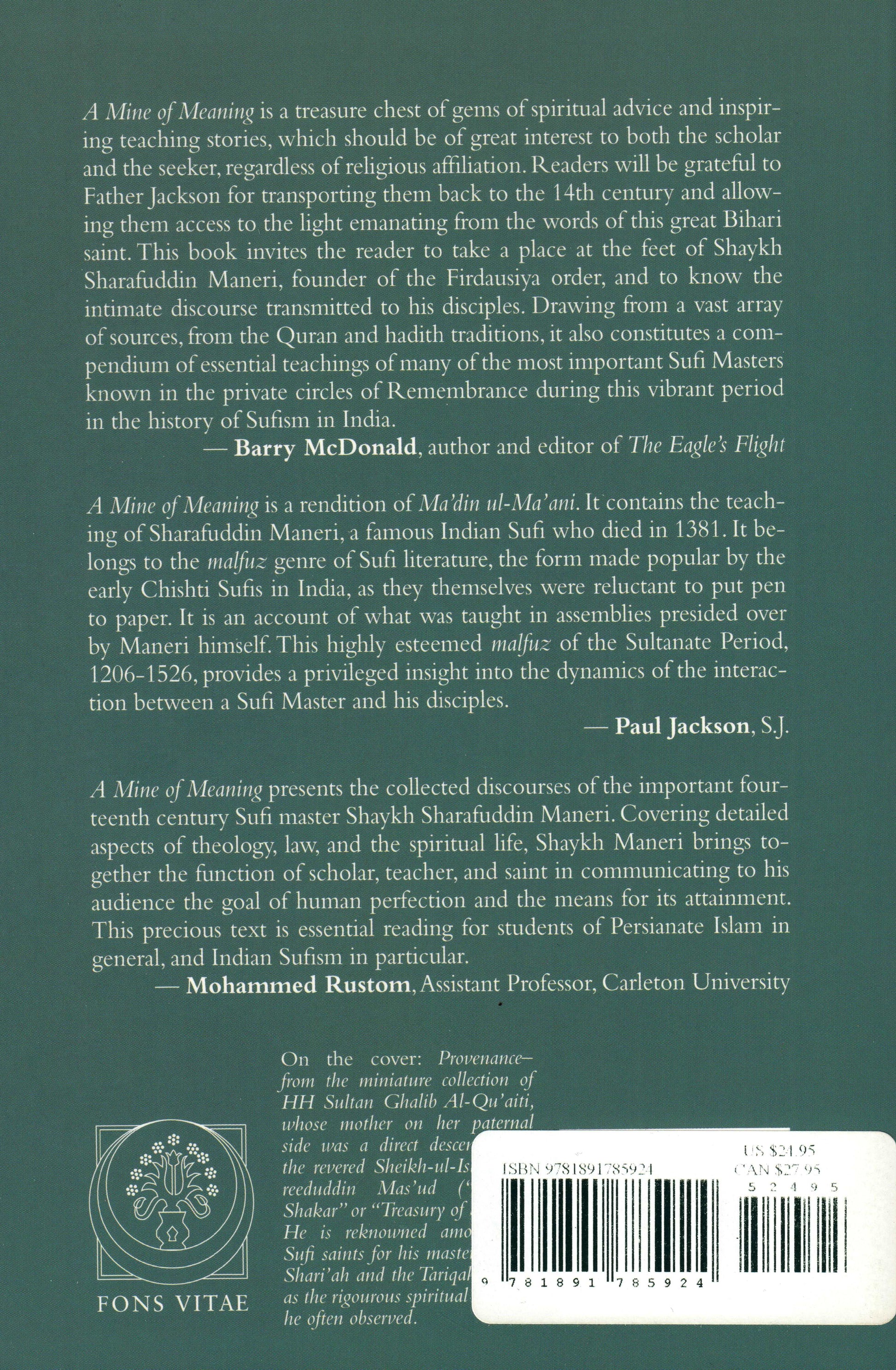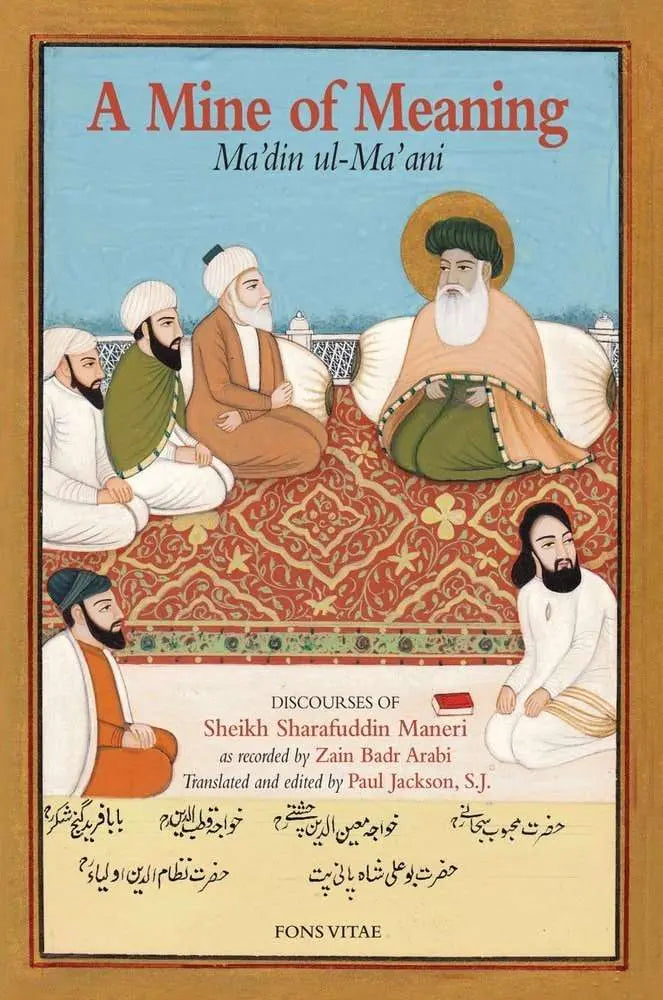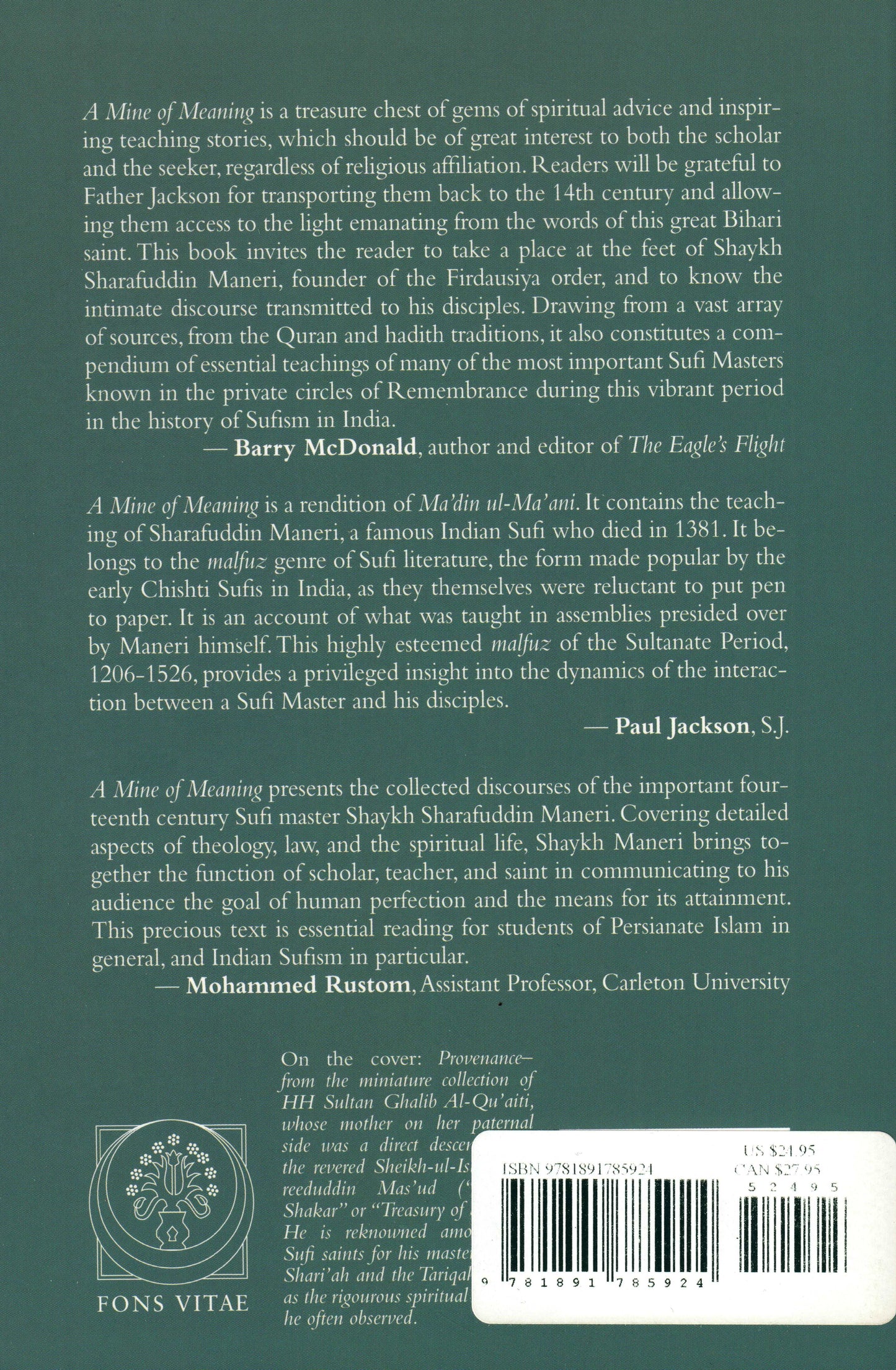About The Book
INTRODUCTION
Ma`din ul-Ma`ani [A Mine of Meaning] belongs to the
These records were normally chronological in nature. Often the actual date of the assembly was given, and even the time of the day. This is not the format followed in A Mine of Meaning. To begin with, no dates are given in the work itself, which was compiled by Maneri's faithful secretary, Zain Badr Arabi. If we turn to Khwan-i Pur Ni`mat [A Table Laden with Good Things], however, we discover when the work was completed. A Table Laden with Good Things was, in fact, the second
This information clearly states that the work was completed prior to 8th November 1348. It also indicates the time frame in which Zain produced his second volume. It covered a period of two years. Moreover, it contained forty-seven assemblies, but these
Zain provides another important piece of information regarding the chronology of A Mine of Meaning. He was also the compiler of the letters written by Sharafuddin Maneri to Qazi Shamsuddin, the official in charge of the township of Chausa. He wrote: "At various times, from the region of Bihar, in the year 747 A.H. [24th April 1346 to 12th April 1347], he ordered them to be sent to the aforesaid township [Chausa] to the petitioner just mentioned [Qazi Shamsuddin]. This is the collection the servants and attendants who were present in that dwelling place compiled from those letters, arranging them in the following order so that, on the day and hour when grace befriends them, they might put into practice what they have read."
Although Zain refers to "servants and attendants" who were involved in compiling the letters, "arranging them in the following order," it is clear that the bulk of the work was done by Zain himself. Maktubat-i Sadi [The Hundred Letters] was a huge literary enterprise. An English translation runs into 424 pages. The letters averaged two a week during the year-long period mentioned. It is difficult to see how Zain could have been involved, to any marked degree, in another literary
In his preface to the present work, Zain clearly states that "he assisted at every assembly, where genuine seekers, dependable disciples
The phrase, "after putting together this compilation" is significant. Clearly, Zain had been recording what had been said and done in the assemblies over a number of years, perhaps four to six years. This was done in the normal chronological manner. It is possible that Zain had this material at hand when the work on The Hundred Letters began. These letters brought home to Zain the benefits of material prepared topic wise, not merely in the necessarily scattered format of a chronological presentation. This could have provided the impetus to put his material into the sixty-three chapters of the present work. Chronology was no longer the organizing factor and was abandoned. It was this 'compilation' that Zain brought before his Master, possibly late in 1347, if he had rearranged his material after completing work on The Hundred Letters, with his request that Maneri
This aside needs to be read in the context of the following statement in Zain's Preface: "Sometimes, during the reading, he would add a suitable anecdote or example to confirm his teaching." If the material in chapter 13 dates back from a few years previously, and if Zain made his compilation in 1347 and the compilation was read out in the assemblies in 1348, prior to 8th November, Maneri's comment would make sense. It would mean that the reading reminded Maneri of his letter on fasting, which was still quite fresh in his memory. It should be noted that Maneri had an excellent memory, as his reminiscences, for example, clearly indicate.
Granted that Zain was recording Maneri's teaching for several years before the whole project of The Hundred Letters was initiated, the question arises as to why he took the trouble of arranging the material topic wise and having it checked by Maneri. The Hundred Letters was a rich mine of spiritual meaning. Zain's basic motive was his unshakable conviction of the enduring worth of Maneri's teaching. It had to be recorded for posterity. Added to this was the desire of an author to see his work "in print," so to say. Zain did not want his efforts to go to waste. There is also the different focus of A Mine of Meaning when compared to The Hundred Letters. While the latter work focussed on the Path to God, the former ranged over a wide spectrum of topics, from minute details regarding the correct way of reciting ritual prayers
A word of explanation seems appropriate about the English rendition of the title. Although the work itself is in Persian, the title is in Arabic. There is nothing unusual about this. Many Persian works have Arabic titles. An author would not hesitate to choose an apt expression for a title to his work if it were in Arabic. A literal translation of the present work would be The Mine of the Meanings. This is where there is a clash between the constraints of Arabic grammar, specifically in what is called "the construct state," and the English use of the definite and indefinite articles. A Mine of Meaning is meant to convey in English the sense of the original Arabic title. The singular 'meaning' has been referred to the plural. Undoubtedly the sixty-three-chapter work is replete with 'meanings.' The work itself, however, is like a
A Mine of Meaning certainly broadens this 'knowledge.' Even more importantly, however, it leads us into a deeper sense of God. This is because of Maneri, besides being a scholar, was a person who lived in the presence of God. It is this 'sense' that is conveyed in the work. It touches people deeply. It is this impact-laden dimension, rooted in Maneri's personal experience, that favors the use of the singular, 'Meaning.'
The Translation
Anyone who has attempted to translate from one language to another knows that there is no such thing as 'the' translation of sentences other than of the most basic ones. One has only to go through the various English versions of the most translated books in the world, the Bible, and the Quran, to see this for oneself.
The first point that needs to be examined in a translation such as the present one is the actual text as found in
There is also the question of the guiding principles involved in the translation itself. As far as anecdotal material is concerned, a certain amount of liberty can be taken to ensure that the story 'flows.' This type of translation is often referred to as "dynamic equivalence."
Translating terms used for various movements in Muslim ritual prayer, for example, has proved quite challenging. English terms have been utilized, as this is a translation into English. Often a short phrase is needed to convey the sense of a particular Arabic or Persian term.
Great care has been exercised in translating theological and spiritual material. The twin demands of fidelity and comprehensibility have both to be respected by the translator. In a number of places, the language may seem difficult. This has to be expected, as the original text often poses very real challenges for a person who can read with competence the original Persian. This is usually because of the nature of the material being presented.
A word has to be said about the poetry found quoted in A Mine of Meaning. To begin with, an effort has been made to give it poetic form in English without attempting to produce genuine poetry, with rhyme and rhythm. This seems a far more accurate way of presenting poetry than by rendering it in ordinary prose form. At the very least, it has a poetic look about it. Moreover, poetry is much more suggestive than explicative, especially the type of poetry enjoyed and quoted by Maneri. The format chosen in this translation is more attuned to the suggestive dimension of poetry than to explanatory prose.
The poetry is, of course, more difficult to translate than prose. No attempt has been made to trace the poetry. Sometimes the poet's name is given. A similar remark can be made about prose quotations. Those from the Quran, however, have been identified and the reference is given. The Endnotes will be of interest to some readers, while others may prefer to ignore them completely.
The Participants
It is worth reflecting on the variety of people present at the assemblies. All would have had an interest in the Sufi Path to God as enunciated and lived by Sharafuddin Maneri. This statement reflects Maneri's own preference for "discipleship through association" rather than "discipleship through instruction." This is an example of the adage, "values are caught, not taught." In fact, however, a lot of teaching is involved, as A Mine of Meaning itself amply illustrates.
Some of those present would have been beginners, novices who were setting out along the Sufi Path. In Maneri's scheme of things, this would normally entail a period of three years. Maneri speaks of this is Letter 5, "Searching for a Spiritual Guide," in The Hundred Letters. "When a novice begins to associate with a spiritual guide, he will have to spend three years in three types of training… one year's service on behalf of other people; one year devoted to God; and another year spent in watching over one's own heart." These novices would have been full time in Maneri's hospice and would have attended all the assemblies.
Another group would have consisted of a few senior disciples who also lived full time in the hospice. Zain Badr Arabi, the compiler of A Mine
One factor common to all who were present in the assemblies was their knowledge of Persian, for this was the language of the assemblies. In the Western half of the widespread Muslim community, such sessions would all have been in Arabic, while comparable gatherings in Christian Europe would have been in Latin. This system allowed people from diverse areas to communicate with one another, either face to face, as in the assemblies, or through correspondence.
The absence of women in the assemblies needs to be noted. This did not mean that they could not make contact with Maneri. This was possible in a semi-private setting, and normally in the local language. In Persian source material from places as far apart as Sonargaon, in modern Bangladesh, to Bihar Sharif and Agra, the local language is referred to as 'Hindavi.' This is a generic term, not a specific one. It indicates the local language, whatever that may have been, as opposed to Persian. Maneri had no trouble quickly mastering the local spoken language, building on his mother tongue that he had acquired in Maner.
Just as there was a variety of people present in the assemblies, so too there was a similar variety among those interested in reading Ma`din ul-Ma`ani once it became available. There was a flourishing book trade in the Islamic world at the time of Maneri, due to the widespread availability of paper. Nevertheless, copying took time, and books were expensive. They were prized possessions. Moreover, the more renowned the author, the more the book was valued. This means that, even though Zain Badr Arabi actually wrote Ma`din ul-Ma`ani, nevertheless, because it contained the teaching of Sharafuddin Maneri, its value was greatly enhanced.
One important question still needs to be raised. "How faithful is Zain's record of what Maneri actually said?" As a literary form, it does not have the authority of the Letters composed by Maneri himself. The subsequent history of these two works shows conclusively that The Hundred Letters was a far more popular and widely read work than Ma`din ul-Ma`ani. This question, however, has already been answered in this very Introduction. The original text, read out to Maneri in the assemblies, and sometimes corrected by him, or added to by him, was accurate. There can be no doubt about this. It is also worth recalling that Zain had a real mastery over Persian, as his various prefaces amply illustrate.
Relevance
The broadest of all questions is the relevance of the life and teaching of Sharafuddin Maneri, a Sufi Master of fourteenth-century Bihar, for people of the twenty-first century.
To begin with, even 630 years after his death, the fourteen million Muslims of Bihar State in modern India still revere him as their greatest saint. Moreover, his writings were widely studied in madrasas and Sufi hospices throughout the Indian subcontinent. His Hundred Letters were read out to Akbar, and Aurangzeb had his own personal copy of the work which he kept with him during his travels. Because of his studies in Sonargaon – probably about eighteen years – Maneri is very well known and revered in Bangladesh. Due to waves of migration from India to Pakistan in the wake of Partition, many devotees now live in Pakistan. Some are also found in the United States, Canada
In the midst of today's violence, fuelled by conflicting ideologies, all claiming to be authentic Islamic teaching, where does a modern Muslim, from Bihar, for example, look for authentic guidance? The basic texts of the Quran and the accepted collections of Traditions are there for all to see, but the interpretations of these texts and the ways of living out a person's faith vary greatly. A Bihari Muslim can safely follow the teaching of Maneri, as expounded in the present work. In addition to the information a reader can pick up, there is also the boon of coming into first-hand contact with Maneri himself, a man totally dedicated to God and to the welfare of his fellow-Muslims. This has both a soothing and reassuring effect on the attentive reader, whoever he or she may be.
For people outside the fold of Islam, yet who wish to benefit from authentic Muslim teaching from a man who was both a scholar and a saint, Maneri has much to offer. In religious discussions, Muslims naturally refer to the Quran, just as Christians refer to the Bible. Within the actual living out of the general categories of Muslims and Christians, however, there are many streams of thought and religious experience. A Dominican priest, for example, who is writing about the challenges faced by contemporary Christians, is almost certain to quote frequently from the writings of Thomas Aquinas, the great Dominican theologian
One very visible sign of the Sufis throughout the subcontinent is
It is convenient to divide the literary material into that of the Sultanate period, 1206-1526, and the Mughal period from 1526 until the changes wrought after 1857, although Sufis continued to flourish even after this political upheaval. The literary output of the Sultanate period is nowhere near as prolific as that from the Mughal period.
It is in this context that Maneri deserves to be heard.
Although political power in the various places where Maneri lived – Maner, Sonargaon, Delhi, Rajgir
One final remark can be made about how Maneri frequently, yet unconsciously, shares with us his own experience. He is loath to make any claims or draw attention to himself. Even his reminiscences, mainly from his Sonargaon days, are didactic in nature, rather than autobiographical. A discerning reader, however, can perceive when his teaching about the human spirit's journey towards God is ultimately rooted more in his own personal experience than in any text he may be quoting. Paul Jackson S. J.
On the cover:
Provenance– from the miniature collection of HH Sultan Ghalib Al-Qu’aiti, whose mother on her paternal side was a direct descendant of the revered Sheikh-ul-Islam Fareeduddin Mas’ud (“Ganj-i-Shakar” or “Treasury of Sugar”).
He is
Contents
- PREFACE xiii
- INTRODUCTION TO MA‘DIN UL-MA‘ANI xv
- A Mine of Meaning
- COMPILER’S PREFACE 1
- CHAPTER 1 6
-
A DESCRIPTION
IN CONFIRMATION OF THE EXISTENCE OF - GOD AND HIS ONENESS—EXALTED BE HIS GLORY!
- CHAPTER 2 15
- A DESCRIPTION OF FAITH AND OF ISLAM, AS WELL AS OF ASSOCIATION,
- UNBELIEF AND SUCH-LIKE THINGS
- CHAPTER 3 25
- KNOWLEDGE OF THE ESSENCE AND ATTRIBUTES OF THE
- MOST EXALTED DEITY
- CHAPTER 4 31
- A DESCRIPTION OF THE METAPHORS WHICH ARE APPLIED TO GOD
- MOST EXALTED, SUCH AS ‘FACE,’ ‘HAND’ AND SIMILAR THINGS
- CHAPTER 5 35
- A DISCUSSION OF KNOWLEDGE OF THE LAW AND OF THE WAY
- AND WHAT BEFITS THEM
- CHAPTER 6 48
- APPROPRIATE QURANIC INTERPRETATION AND MEMORIZATION
- CHAPTER 7 65
- TRADITIONS OF THE APOSTLE: A DESCRIPTION OF SOME OF
- THEM AS VERIFIERS OF THE TRUTH; AND COMMENTING ON
- SOME OF THE SAYINGS OF THE SHEIKHS
- CHAPTER 8 78
-
THE
PROPHETHOO D OF THE APOSTLE: HIS ASCENSION AND - MIGRATION; VISITING HIS BLESSED TOMB; THE EFFECT OF A
- PARTICLE OF THE GRACE OF THE COMPANIONS ON ALL THE BELIEVERS;
- THE EFFECT OF THE GRACE OF THE COMMUNITY ON
- ALL COMMUNITIES; AND A DESCRIPTION OF WHAT IS FITTING
- A Mine of Meaning [Ma‘din ul-Ma‘ani]
vi
- CHAPTER 9 87
- THE MIGRATION: PATERNAL UNCLES: AND THE APOSTLE’S
-
COMPANIONS
OF THE BENCH - CHAPTER 10 93
- THE EXCELLENCE OF THE COMPANIONS COMPARED TO
- OTHER BELIEVERS, AND OF THIS COMMUNITY COMPARED
- TO OTHERS; THE QUALITIES OF A’ISHA, THE MOTHER OF THE
- BELIEVERS; AND THE STRUCTURE OF THE BLESSED TOMB
- CHAPTER 11 102
- PURITY
- CHAPTER 12 110
- RITUAL PRAYER AND ITS CORRECT PROCEDURE
- CHAPTER 13 132
- FASTING
- CHAPTER 14 139
- PILGRIMAGE TO MECCA AND STRUGGLE
- CHAPTER 15 146
- REPETITIVE PRAYER: PRAYERS OF PETITION: RITUAL PRAYER
- AND SUPEREROGATORY PRAYER AT ASSEMBLING POINTS IN
- MECCA
- CHAPTER 16 157
- REMEMBERING GOD MOST EXALTED
- CHAPTER 17 163
- THE MASTER-DISCIPLE RELATIONSHIP, AND WHAT BENEFITS IT
- CHAPTER 18 167
- THE MOULDING OF A DISCIPLE
- CHAPTER 19 174
-
SHAVING ONE’S HEAD: CUTTING, DIVIDING
AND PARTING - ONE’S HAIR: AND WHAT IS FITTING IN THESE MATTERS
- CHAPTER 20 184
- GOD’S SAINTS
- CHAPTER 21 197
- THE SECRET THOUGHTS OF HOLY MEN
-
Contents, continued
vii
- CHAPTER 22 205
- THE GENEALOGICAL TREE OF THE SHEIKHS AND SEEKING
- THEIR INTERCESSION IN TIMES OF NEED
- CHAPTER 23 206
- STRUGGLING AND GAINING MASTERY
- CHAPTER 24 215
- SHOWING DISPLEASURE TOWARDS ONE’S SELFISH SOUL: A
-
DESRIPTION OF ITS PERSISTENCE: AND A PEEK AT ITS HIDDEN - NATURE
- CHAPTER 25 227
- CUTTING ONESELF OFF FROM PEOPLE AND FROM ONE’S
- VERY SELF: AND WHAT PERTAINS THERETO
- CHAPTER 26 234
- ASCETICISM AND FEARING GOD
- CHAPTER 27 239
- FEAR AND HOPE
- CHAPTER 28 244
- WATCHFULNESS AND MEDITATION
- CHAPTER 29 252
- SERVANTHOOD AND SERVITUDE
- CHAPTER 30 256
- FREEDOM AND WHAT IS CONGRUENT WITH IT
- CHAPTER 31 261
- CONVICTION
- CHAPTER 32 267
- LOVE
INDEX 281
----------------------------------------
Reviews
A Mine of Meaning is a treasure chest of gems of spiritual advice and inspiring teaching stories, which should be of great interest to both the scholar and the seeker, regardless of religious affiliation. Readers will be grateful to Father Jackson for transporting them back to the 14th century and allowing them access to the light emanating from the words of this great Bihari saint. This book invites the reader to take a place at the feet of Shaykh Sharafuddin Maneri, founder of the Firdausiya order, and to know the intimate discourse transmitted to his disciples. Drawing from a vast array of sources, from the Quran and hadith traditions, it also constitutes a compendium of essential teachings of many of the most important Sufi Masters known in the private circles of Remembrance during this vibrant period in the history of Sufism in India.
— Barry McDonald, author
A Mine of Meaning is a rendition of Ma’din ul-Ma’ani. It contains the teaching of Sharafuddin Maneri, a famous Indian Sufi who died in 1381. It belongs to the
— Paul Jackson, S.J.
A Mine of Meaning presents the collected discourses of the important
— Mohammed Rustom, Assistant Professor, Carleton University




